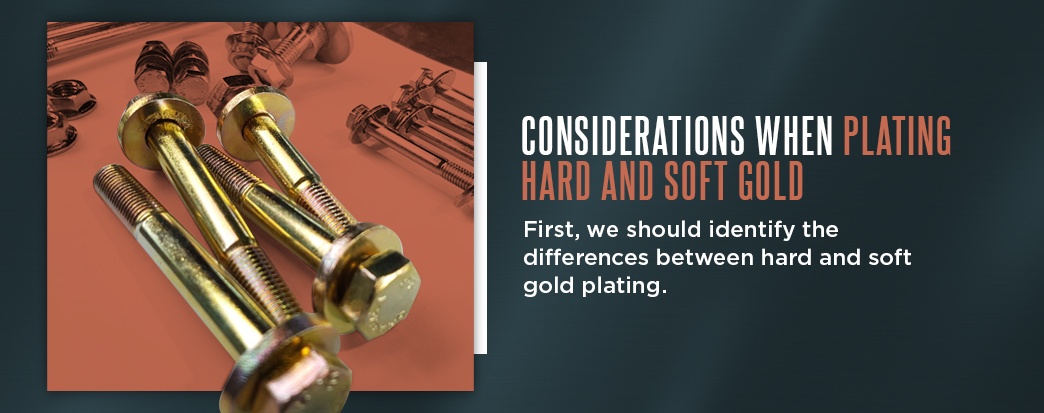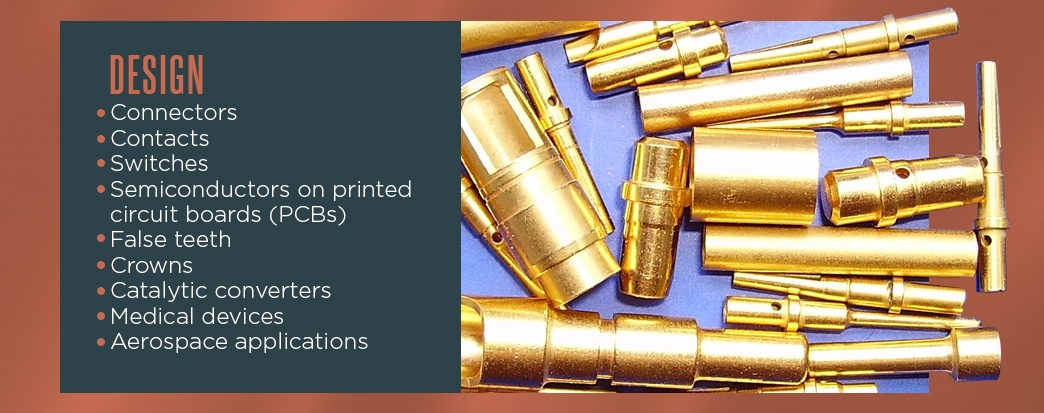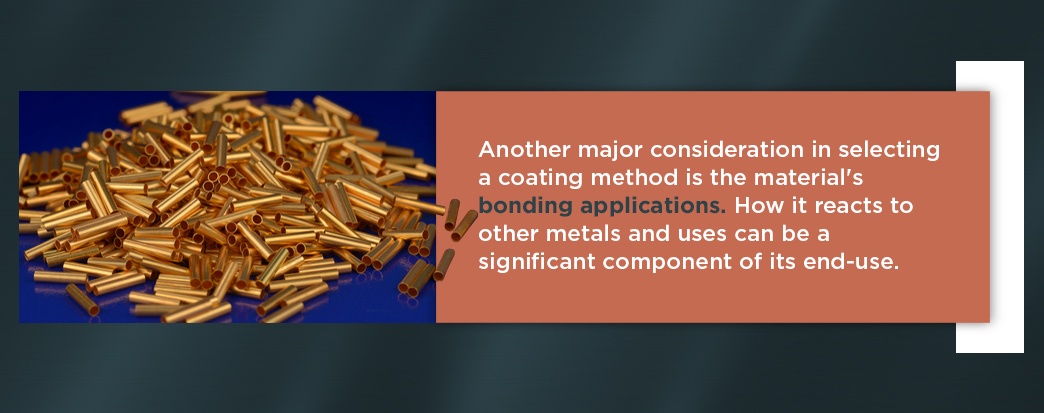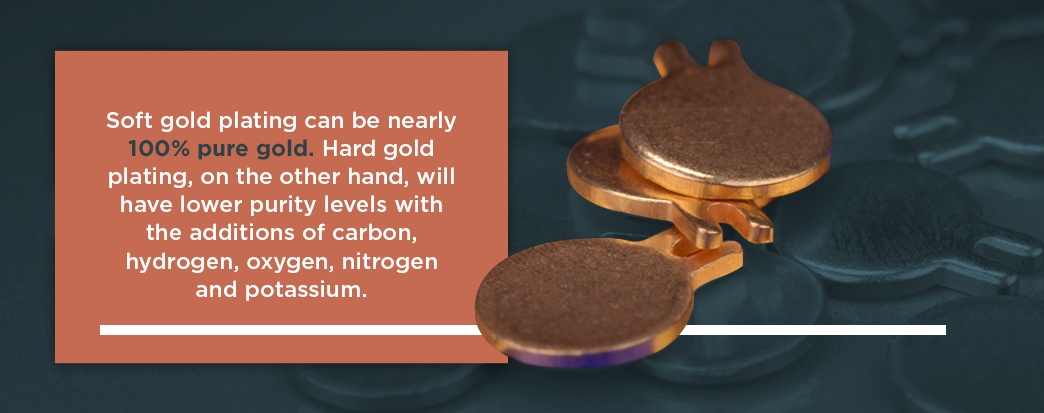Gold has always held a sparkly reputation in jewelry and decorative accents, but many are unaware of its uses in the world of electroplating. Along with its excellent electrical conductivity, gold offers many benefits, from corrosion resistance to biocompatibility.
However, not all gold plating is the same, which is mainly due to the solution or plating bath in which it is created. As a manufacturer, you have the option to select hard or soft gold plating for the finish of your products. It is crucial to gain a general understanding of the two processes so you can make an informed choice for your manufacturing operation.
Quick Links
Considerations When Plating Hard and Soft Gold | Design
Buy Soft and Hard Gold Plating
Considerations When Plating Hard and Soft Gold
First, we should identify the differences between hard and soft gold plating. In hard gold plating, the gold electrodeposit is alloyed with another element, like nickel, cobalt or iron, to add strength or other characteristics. The alloy plating combines the gold with these other metals. Soft gold plating foregoes this additional element, using pure gold to create the coating. Both options have advantages and disadvantages, depending on many wide-reaching factors.
When deciding whether to plate an object in hard or soft gold, it is important to take note of a wide variety of characteristics about the gold itself and the item behind plated. Two major components that stand out for their importance are the design of the piece and bonding characteristics. These two properties determine many of the foundational aspects of a gold coating, including how it responds to its environment and how much strength it has after additional tasks, like soldering or implanting, are performed.
1. Design
Many components benefit from gold plating, but some of the most common ones are:
- Connectors
- Contacts
- Switches
- Semiconductors on printed circuit boards (PCBs)
- False teeth
- Crowns
- Catalytic converters
- Medical devices
- Aerospace applications
Considering the end-use of a product is vital when selecting hard or soft gold. Soft gold is more prone to being removed from abrasion. Items that will be handled frequently or chips that will be inserted and removed repeatedly may be better served with hard gold, due to the nature of their use. The environment of the item is also critical to consider. Dental work placed in the mouth, for instance, has substantially different requirements for corrosion resistance than a semiconductor may need. One method to improve the performance of gold plating is to add an underlayer.
An underlayer may offer unique qualities that improve the performance of a gold-coated piece. Nickel, for example, can perform several functions, including:
- Preventing pore corrosion: A nickel backing creates oxides beneath the pores of a gold coating and can help prevent the effects of corrosive elements or pollutants that may seep through, keeping them off of the base metal.
- Inhibiting corrosion creep: Nickel can also prevent the products of corrosion damage from migrating across the surface of a PCB.
- Blocking diffusion: As a diffusion barrier between the base metal and the gold, the underplate keeps certain oxidizing materials from corroding the metals. It prevents poorly bonded intermetallic layers from forming between the gold and the base metal. This characteristic may be particularly useful at high temperatures, where oxidization can occur more rapidly.
- Supporting contact surface strength: By adding hardness via a coating of nickel, an underlayer can increase the durability of the gold coating. It may prevent cracking in hard gold plated contacts and protect against contact loads.
- Improve surface finish: Applying brighter underlayers can help improve the color and finish of the gold plating.
When designing parts for electrical use, the thickness can be an important feature. Gold is a costly material, so most businesses want to use it as little as possible. Depending on what you are making, some standards may be in effect, such as those from ASTM International. Outside of any imposed rules, you’ll need to consider these factors when determining thickness. Thin plates can make soldering easier, as they are less likely to cause embrittled joints, but they won’t prevent corrosion as effectively as a thick plate. Thinness can increase the pores in a coating, which in turn can reduce its corrosion resistance.
You’ll also have to consider the process used for the plating. On circuit boards, two methods are popular — Electroless Nickel Immersion Gold (ENIG) and Electroless Nickel Electroless Palladium Immersion Gold (ENEPIG). Both are ways to plate PCBs using slightly different materials.
- ENEPIG adds palladium between the nickel and gold layers to prevent the corrosion of the nickel layer. ENEPIG is good for solderability and has a high capacity for wire bonding.
- ENIG provides a smoother surface, good oxidation resistance and better electric conductivity, but it is affected more by the thickness of the plating and can cause “black pads.” Black pads occur when the nickel erodes in an ENIG coating, leaving behind the base metal. ENIG is a form of soft plating.
A contact coated in soft gold typically has low durability and high insertion forces — that is, a high coefficient of friction. These aspects are especially true at higher thicknesses. Hard gold coatings often result in a lower coefficient of friction but excellent durability. They can withstand many durability cycles before failure. Lubricants or an underlayer of nickel can even improve the strength even further.
2. Bonding
Another major consideration in selecting a coating method is the material’s bonding applications. How it reacts to other metals and uses can be a significant component of its end-use. While the added non-noble materials like nickel, cobalt and iron in hard gold plating impart strength on the coating, they also make it more difficult to solder. This difficulty is due to the materials’ tendencies to oxidize at the high heat created during soldering. This oxidization can also make the solder joint less stable. In projects where joining is particularly vulnerable, you may need a metal that solders better. Soft gold tends to offer easy soldering, as it does not combine with the oxygen in the air. This property is why cheap “gold” jewelry quickly discolors your skin — it may actually be an alloy that reacts with oxygen as it rubs off.
Thickness is one component of bonding that can influence the performance of gold plating. A thick layer of gold tends to make soldering more difficult, as the gold dissolves in the bond between the solder and the substrate metal. Aim for the minimum thickness possible, typically a maximum of 20 µin. Dewetting, or the process of a liquid retracting over a surface, can occur, which causes a soldering failure and often comes from excessive impurities within the gold film. To avoid these issues, the plating process needs to be performed carefully and treated to remove any excess foreign substances that could influence the purity of the gold.
Underplates can also affect the bonding properties of a metal. On a soft gold coating, the solder joint and wetting occur on the gold layer. If the gold rapidly dissolves into the solder joint, the final bond can occur at the underlayer. If this layer is not a suitable surface for soldering, the joint may dewet. Nickel that is high in purity can help maintain a robust solder joint if it is used as an underlayer.
3. Other Factors
Aside from the overall design of the piece and the bonding properties of the metals, there are a wide variety of other aspects to consider when comparing hard and soft gold. These factors can include the exposure of the item to corrosive environments, any uses in the human body, the resistance to wear, the need for adequate contact force, the temperature in which it will be used and the appearance the item will have.
Corrosion Resistance
Soft gold plating can be nearly 100% pure gold. Hard gold plating, on the other hand, will have lower purity levels with the additions of carbon, hydrogen, oxygen, nitrogen and potassium. Soft gold, containing none of these non-noble elements, is much more resistant to corrosion than hard gold plating due to the inherent properties of gold. It can protect against acids and exposure to other elements.
This characteristic makes gold an excellent substance for use in humid or highly corrosive environments. Sulfur and chlorine gases often attack metals such as copper or nickel and can impede their ability to provide sufficient electrical contact. Gold, however, is not as susceptible to these conditions and can more readily protect components from the environments in which electrical devices are commonly present. The added materials in hard gold plating can react differently to environmental conditions like moisture and heat.
Gold’s corrosive-resistant properties are more effective when there are no pores or cracks present in the coating. Through these openings, pollutants can penetrate the gold finish and reach the base metal. Minimal amounts of pores are typically acceptable, but it depends on the environment and the item’s intended use. Adding a layer of nickel underneath the gold can help keep this corrosion at bay. It helps to create an additional diffusion barrier.
Biocompatibility
In addition to corrosion resistance, soft gold’s ability to maintain its structure makes it better for medical use. Biocompatibility refers to how a substance interacts with the body. Soft gold does not react to the biochemistry of living things, so it is more suitable for medical applications where it may come in contact with the body. Dental items, such as crowns and caps, and implants benefit significantly from a soft gold coating. Often, metal alloys tend to corrode in oral applications after being exposed to food and saliva, making them less suitable as materials for dental use. Gold, however, is very resistant to both corrosion and oxidation. A gold finish is excellent for applying to devices to increase their resistance to these materials. These are a few of the benefits that gold plating offers to the medical field:
- Biocompatibility: Gold is a metal that doesn’t harm the body with any adverse reactions. Gold doesn’t react with oxygen, moisture or acids, so devices can be safely inserted inside the body without worry about its compatibility. This property sometimes allows us to coat other items to make them suitable for implementation, as well.
- Radiopaque: Gold has a very high density, which makes it highly visible on medical imaging software such as X-rays. This feature becomes incredibly useful if doctors need to examine an implant or other electroplated items. They know that any device made of gold or with gold plating will show up well in imaging.
- Malleable: Compared to other metals, gold is quite soft. It is much more flexible and can be shaped into delicate or intricate designs.
- Corrosion-resistant: Gold’s high resistance to corrosion makes it excellent in preventing rust or protecting against acids. When placed in the body, the corrosion resistance can lessen safety concerns or worries about the performance of an implant or device.
With biocompatible materials, we can more readily work within the human body and negate the adverse effects of harmful substances that may have other positive effects. Gold plating allows us to adapt the surfaces of these substances, so we can use them in devices and items that heal rather than harm.
Wear Resistance
Wear resistance is heavily related to a metal’s hardness, which is, in turn, related to the grain size of a coating. Though hard gold contains less than 0.4% by weight of cobalt or nickel, the deposit hardness increases to over twice that of soft gold deposits. Soft gold has a hardness of 70 to 80 kg mm-2, while hard gold can have a hardness of between 170 and 200 kg mm-2 on the Knoop hardness scale. These hardness ratings have to do with the size of the grain on the surface.
When non-noble elements are added to the gold deposit, the grain structure of the deposit changes. It offers a fine grain that resists sliding wear more effectively. Hard gold, therefore, contains a very fine grain of about 20 to 30 µm, while soft gold plating is around 1 to 2 µm — much larger than that of the hard gold. Many experts believe this difference in grain size is due to the inhibition of crystal growth. Typically, gold hardens in a way that creates crystals and spaces out the grains, but with the addition of impurities, such as nickel or cobalt, the crystals do not form as easily, and the gold can harden to a finer grain. A fine grain makes it more difficult for the gold finish to be brushed off or worn away.
Contact Force
In electronic applications, such as on connectors and switches, a piece’s ability to impart steady, low electrical signals is a vital component of its physical properties. Some metals, when combined with gold, increase their contact resistance to unacceptable levels in certain conditions. In cobalt-hardened gold, for instance, this increase is often due to oxidation from the cobaltous oxide, or CoO, that forms on the surface of the gold. Other factors that can influence contact resistance include elevation and high temperatures. High temperatures can accelerate the oxidation process and increase contact resistance. Typically, soft gold plating offers better contact resistance since it is purer. ENIG offers excellent resistance to oxidation, and, being a form of soft gold plating, creates lower contact resistance.
Normal contact force must be kept in mind when deciding on hard or soft gold plating. In electrical circuits, many metals interact with oxygen to create hard oxides that are electrically insulating. To displace the film and create a path for the current, normal force or a wipe is performed. Gold does not create this insulating layer and requires much smaller forces to operate efficiently. About 10 to 20 grams of force with wipe less than 0.254 mm is typically enough to establish contact resistance. Anything above that can improve the stability of the contact interface and reduce fretting disturbances.
This feature is due to the lack of oxide, which has insulation properties, and compound formation. Hard gold is preferable to projects that require regular sliding wear or make/break switching events, which offer longer lifecycles based on the thickness of the gold. Thicker gold deposits can power through more use cycles. In PCB design, gold contacts are often used in combination with something like a keyboard, which sees many cycles of actuation. Hard gold can withstand many actuation forces.
Temperature
Again, the temperature in which a metal part operates can affect some characteristics of gold plating. Notably, high temperatures increase the contact resistance through oxidation. In both cobalt and nickel hard gold plating, researchers found that the contact resistance of gold is a function of both temperature and time. They found that increased contact resistance occurred after 41 days at a temperature of 125 degrees Celsius. When the temperature rose to 300 degrees Celsius, the gold plating could only withstand the environment for a minute before experiencing increased contact resistance.
High contact resistance can be a major issue for many electronic applications. This resistance must be kept low in those instances where low, stable resistance is required. Soft gold plating has a much lower contact resistance than hard gold plating. Increased thickness, along with a layer of nickel, can help address the issue of contact resistance when used in environments of over 125 degrees Celsius.
Appearance
With the smaller grain size of hard gold plating, you get a brighter finish than soft gold plating. It is lighter and shinier, which is often more attractive when you’re looking for visual appeal. However, soft gold plating is, well, soft — it’s about as hard as your fingernail. This characteristic makes it much more susceptible to wear and to burnish. You may find yourself with a finish with scratches and marks appearing, so while it may start with an aesthetically pleasing look, it can fade over time. This characteristic makes soft gold better for applications that won’t be handled much. Hard gold stands up much better to contact and may be better suited for something like visible interconnect projects.
The metal underneath the gold plating is valuable as well and should not be ignored. Remember that a plating such as nickel can add functional benefits like better soldering, bonding and higher hardness. With those useful features, you may lose out on some of the cosmetic ones. The addition of some backings can result in a more matte finish, which may or may not be desired, depending on the end-use. Other backings can offer a brighter gold finish. Even though it may be more vivid, their functional characteristics may be weaker than those of other metals. Hardness and bonding ability are often more inadequate with these metals.
Your Provider for Soft and Hard Gold Plating
Hard and soft gold plating can have major effects on the result of a project. The chosen type of plating can influence everything from a piece’s response in high temperatures to its compatibility with the functions of the human body. When designing with electroplating in mind, it is important to consider all of these factors, along with the general design and end-use of the item.
Regardless of the type, gold plating is an effective way to adjust the surface properties of a wide variety of materials. It can improve resistance to corrosion, make a product withstand biological substances and maintain low contact resistance. With Sharrett’s Plating Company, you can add gold plating to a variety of unique materials, including plastics, ceramics and glass.
With more than 90 years of metal finishing experience and expertise, you can count on the professionals at SPC to help you make the ideal gold plating choice for your applications. Feel free to contact us to explore your options and get a free quote today.













